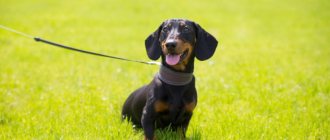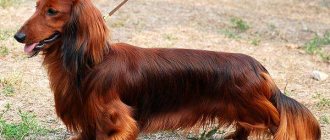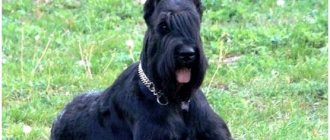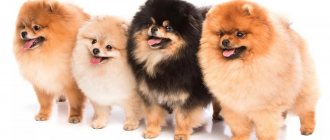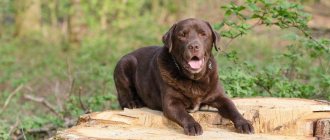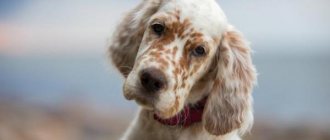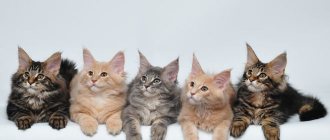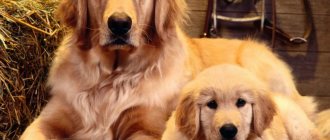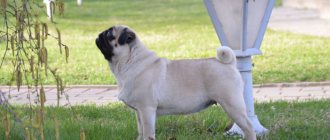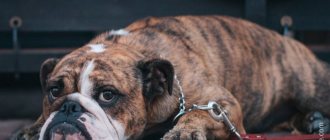People who are not too familiar with this breed believe that dachshunds should be exclusively black or red, well, in extreme cases, brown and tan.
However, in fact, even in the standard, dachshunds have quite a lot of colors, and quite rare and unusual ones.
And if you add non-standard colors to them, it turns out that the color palette of coat colors of these dogs can be incredibly extensive.
What colors, in principle, can be found in dachshunds and which of them are allowed by the breed standard?
Dachshund color standard according to RKF
The Russian Canine Federation has officially recognized the following colors for all types of dachshunds:
- brown and tan;
- redhead;
- black and tan;
- brindle;
- marble based on brown or black.
Boar coloring is allowed only for wire-haired dachshunds.
Fans of the breed know that there are also officially unrecognized colors, for example, sable or isabella. They are rare, but are of growing interest among hobbyists.
Price range
Typically, the price range for dachshund puppies is wide. Market puppies range in price from $30 to $100 . They will demand more for the pedigree.
Here the cost reaches $300, and for small breeds the prices are even higher. This is explained by the increased attention and popularity of miniature dogs.
Moreover, in litters of small dachshund breeds you rarely see more than 4-5 puppies.
For example, the price of a purebred rabbit dachshund reaches $1,000.
Colors of dachshund varieties
The permitted colors are relevant for all sizes of dachshunds - the RKF has approved a single breed standard for color.
The only difference in possible coat color is allowed for wire-haired dachshunds of any size: they are allowed boar color, which is a defect in representatives of the breed with a different type of coat.
It can only be noted that fans of the dwarf variety show increased interest in complex and unusual coat colors. This is understandable, because the main value of a mini-dachshund is its decorativeness, and not its performance characteristics.
How to feed
Dachshunds have a high tendency to diseases of the digestive system, which places a certain burden of responsibility on the owner in choosing the diet and portion sizes.
First of all, the diet should be rich in meat, fish and offal (2/3) . The remainder is occupied by vegetables and fruits. This will replenish the level of vitamins and minerals in the body.
The introduction of fermented milk products high in calcium is also encouraged.
Remember that the diet is based on the caloric content of foods (90 cal per kg of weight) . Your dachshund should always have access to water to prevent the development of kidney disease.
Popular colors
Dachshund colors are divided into three main groups:
Plain
The most popular solid coat color for dogs. The standard describes the colors red, fawn and tan. An even coat tone is preferred on all parts of the body (red is considered the most valuable), but areas with a greater or lesser density of black hairs are acceptable. The presence of white is not acceptable, but minor white spots or hairs are acceptable and will not disqualify the dog. The nose, like the dog’s claws, is most often black, but reddish-brown shades are acceptable.
Two-color
Classic dachshund color. Its base is intense brown or black. The color of the tan marks can range from light sand to intense red and contrast with the main tone. The border between the base color and tan cannot be uneven or blurred.
Scorches can only be located in strictly permissible places:
- underlip;
- muzzle on the sides;
- brows;
- inner part of the ear;
- breast;
- around the anus;
- legs from the inside.
The color of the nose should match the base color of the coat. Small white spots are not approved, but the dog is not rejected.
Difficult
These include brindle or marbled dogs.
The base color of merle dogs is dark (gray, black or tan). Gray and beige spots should not be large and should be randomly located. The brindle color is based on a red or beige background with dark, uneven stripes of different widths, the so-called brindles. The color of the claws and nose is dark.
Photo of what it looks like
The dachshund is easy to find among a number of other dogs.
The animal has short stature and an elongated body . But, despite the short legs, the dachshund can hardly be called clumsy. Whether walking or running, the dog is characterized by free movements, and a high raised head only highlights the beautiful bend of the posture.
The dachshund also has a strong, muscular body . The breed has a rich past, which to this day haunts animals, not allowing them to forget about their roots.
So, for example, a dachshund is a good watchman who, if he does not detain an intruder, will at least scare him away with a loud voice.
This is a selfless pet and family friend . Active but balanced.
Rare colors
In addition to the extensive list of traditional colors, they now have many unusual coat colors. Many colors are not accepted by the official breed standard, and some are serious defects. Dogs of some coat colors have significant genetically determined problems with immunity and general health.
Brindle and marbled dachshunds are officially recognized.
Unique coat colors include isabella (a mix of cool beige-brown shades), sable (similar to red, but more complex), cream, and grey-tan (cool gray with light brown or sandy tan markings).
The most problematic in terms of health are white dachshunds, especially albinos, and double merles.
Such a variety of appearance allows you to choose a dachshund puppy to suit your taste. If the puppy is chosen as a pet, and not for exhibitions and breeding, then it is not at all necessary to choose a color approved by the breed standard, the main thing is that the puppy is healthy and loved.
Crossbreeds and mestizos
Mixed breeds are dogs obtained by crossing different breeds. Dachshund crosses are always somewhat similar in appearance. One of the most common dachshund mixes. The following is a description and photo of dachshund crosses and hybrids.
With a spaniel
Spaniel crosses are more similar in appearance to spaniels. However, their body is slightly elongated, and their character is explosive.
With Jack Russell
This large dog is reminiscent of a Jack Russell in color and has an elongated body. The animal is very active, becomes attached to its owner and gets bored when alone.
With Spitz
In its “dimensions” the dog is more similar to its oblong parent, and in its fur it is more like a Spitz. Spitz crossbreeds have a strong sense of self-esteem and are very stubborn. And they are also quite difficult to teach anything.
With a beagle
Externally, the beagle hybrid is harmoniously built, the body is slightly elongated, the paws are of medium height. Such dogs are smooth-haired, and their character is good-natured and flexible. Very active, love walks.
Among the many varieties of colors, as well as several subspecies of the breed, you are sure to find an animal that suits you not only in appearance, but also in character. By clearly imagining what exactly you want to see in a four-legged pet, you will find in him a faithful companion and devoted friend.
Popular colors
Ginger
This color is very common among dachshunds. The standard recognizes all possible colors of red, from light beige-gold to dark red with a reddish tint. The most even and bright colors are highly valued. Often there is a red color with muruzina (corresponds to the standard) - black hairs varying in density and intensity.
Brown and tan
Basic brown is combined with tan tones of red. The scorch markings must necessarily contrast with the main background, the saturation of which may differ. Adult dogs should have brown eyes, but some puppies initially have gray or green irises. With age, the eyes become standard brown, so such dogs are not disqualified.
It is very rare to find individuals that appear completely brown. They still have a tan, but it is darkened. This option is not a defect, but is regarded as a disadvantage.
Black and Tan
It is considered the most classic variant of the coat color of dachshunds: on the main intense black background, there are reddish tan marks in certain places. The standard allows for a small white spot in the center of the chest.
Black
Pure black color is not recognized as a standard; such individuals are removed from breeding. Non-rejected dogs only look black, in fact they have a darkened tan that almost blends in with the base tone. When assessing a dog, they look for the presence of red hairs on the dog's paws, face or eyebrows. If such hairs are present, then the color is considered black and tan with a slight flaw.
Boar color
Visually similar to the color of boar bristles. It is traditionally called boar in any hunting breed; in other breeds it is called agouti. This coloring is an alternation of transverse black and brown areas on the hairs. The saturation of the pigment can be different, which means the overall color seems more saturated and darker or lighter. The official standard recognizes this color as acceptable only in wire-haired dachshunds; in other types of the breed, this color is considered a defect.
Marble
Two color options are recognized as standard: black marble and brown marble. Traditional tan must be present. Only these dachshunds are allowed blue irises, which is prohibited by the breed standard for other colors. Heterochromia or a blue coloration of the eye sector or even a blue sparkle is possible. The presence of blue in the iris indicates the presence of the Merle gene in that dog.
There are also double merle (it contains white color) and red merle, which are recognized as a defect in the breed.
brindle
The ideal color is one with noticeable black tiger stripes, which are evenly distributed over the entire surface. However, the color is recognized as brindle even if the red individual has only a couple of low-contrast stripes. It is interesting that these dogs often have classic brindle-colored puppies in their offspring.
Chocolate
In fact, this is an alternative name for the brown and tan color, albeit unofficial. Usually it is a classic light brown with the obligatory tan color close to milk chocolate. A brownish color with a reddish tint is acceptable.
Other types
In the canine literature, types of dachshunds are distinguished depending on their size. In this case, the main parameters are taken into account:
- height;
- weight;
- chest circumference.
During the selection process, 3 groups of animals emerged and were named:
- Standard (sometimes mistakenly called Royal).
- Dwarf.
- Rabbit.
Ordinary adult individuals are characterized by average sizes: height 0.2-0.27 m, body weight up to 9 kg, chest volume 35 cm. The dwarf type is somewhat smaller: height 0.14-0.21 m, weight 4-5.5 kg , chest girth 30-35 cm. Rabbit dachshunds belong to the category of mini pets. Their height at the withers does not exceed 0.15 m. Mature animals weigh approximately 3.5 kg. The chest reaches a volume of up to 30 cm.
Dogs of standard sizes have full hunting properties; small varieties were bred for decorative purposes. They do an excellent job as pets. Miniature dachshunds appeared on Russian territory at the end of the 20th century.
In addition, experts in the field of cynology also distinguish between animals according to the place where they were bred, conventionally distinguishing the German and American dachshunds.
Which type of dachshund do you like best?
Rare colors
White-spotted
The basis of this color is white, along which large spots of reddish-brown or black are located in a chaotic manner.
Two-color
The opposite of the white-spotted pattern: white spots on a dark background should occupy no more than 50% of the body. The color is not recognized as an official standard.
Blue
This coat color is distinguished by a noticeable bluish tint with a basic silver-steel or graphite-gray tone. Tan may be present. Such dogs are very impressive, the color looks unusual. It is not recognized by the breed standard.
Grey
This color is similar to blue, but with a slightly warmer shade of coat color, there is no bluish tint. The darkened tan can move closer to the main color until it completely merges visually.
Sable
The highlight of this rare color is the uneven color of each hair: there is a black pigment at the tips. Visually, it looks like a dark coating on the dog’s fur. This color may differ in the color of the “spraying”: the pigment will not be black, but brown.
Basic rules of care
When caring for the coat, a terry towel and a bristle brush (not hard) are welcome.
Water procedures should be carried out exclusively in warm water and shampoo should be used no more than 3-4 times a year.
The eyes are also susceptible to contamination. Timely cleansing of secretions that accumulate in the corners of the eyes is required. The procedure is carried out using a cloth pre-moistened in warm water.
Regarding the ears, it is recommended to carry out a monthly check with an examination of the ear canals, followed by the removal of wax and dirt. Cleansing is carried out using a cotton swab moistened with warm water or Vaseline oil.
NOTE!
In dental care, it is recommended to purchase special brushes, gels and pastes.
The nails are trimmed with a special nail clipper once every 3 months (for a puppy once every 2 weeks) as they grow .
Defective colors
Cream
Puppies of this color are currently born only to long-haired dachshunds. Outwardly it looks like pale red, and sometimes almost white, but with an inconspicuous tea or yellowish tint. The color is not recognized as acceptable.
Black brindle with tan
This variety is black and tan. It differs from the color variant recognized by the RKF in that it is not a single-color tan with the presence of stripes or brindles on them. Recognized by tribal marriage.
Isabella
Very light chocolate tone or coffee with milk. Isabella dachshunds are distinguished by weak immunity and a bunch of genetic problems accumulated by the family branch. Such puppies are born from the mating of brown and blue parents and are very rare.
White
White dog, pink nose (black or brown, for example). The eyes can have black or brown eyeliner, and the lips can be lined. The iris of the eyes is necessarily brown. This color is categorically not allowed by the standard, especially in the case of albinism, as it is combined with serious genetic health problems. An albino dachshund can be easily distinguished from a true white one by the color of its eyes: albinos are characterized by lightish pupils, and the iris of the eye can be pale blue or reddish.
Double merle
The second name is double marble. Carriers of this color have rather problematic health. Puppies of this color can be born if both parents have a merle color. It differs from classic marble in the presence of white color. The eyes are often blue. Heterochromia occurs. Particularly big problems arise with weakened colors - Isabella or blue. These colors are associated with severely weakened immunity, and congenital deafness and blindness are common. It is considered a serious marriage.
How to choose?
When choosing a puppy, it is advised to pay attention to:
- Tail shape. The tail is smooth, mobile and without deformation.
- The bite, the correctness of which begins to be assessed as early as 4 weeks.
- Presence of a hernia. This is not dangerous, but in the future you will not be able to do without surgery, and therefore a good chance to reduce the cost.
- Musculoskeletal system. Avoid puppies with waddling bottoms and floppy legs.
Healthy puppies, as a rule, are willing to make contact, so if your pets run away when you approach, it’s a reason to think about a breeder.
Also remember that the market is replete with non-purebred breedings, which are often passed off as thoroughbreds. The buyer may be sold a puppy, which in the future will grow up with proportions atypical for a dachshund, and shown someone else's dog under the guise of its mother.
History of the breed
This oldest burrow breed originated in Germany. Although such short-legged dogs can be found in ancient Egyptian images. But they started breeding only in the 16th century in South Saxony. Ancient German hunting dogs – Brackets – took part in the breeding. These were hounds, and a new breed was bred to hunt badgers.
The dog turned out to be very smart, loyal, and hardy. Therefore, by the 17th century it became popular in Germany. It was convenient to keep it in your house or city apartment. Gradually the breed began to spread throughout Europe. At that time there was no single breeding line; different breeders paid attention to different qualities. Therefore, several types of dachshunds appeared. The breed standard was first adopted in 1870. The dachshund was recognized as a hunting burrowing dog and was placed in a separate group.
The first representatives of this breed appeared in Russia in the 18th century. But they became popular only a hundred years later. At that time, most people kept a dachshund as a pet. Although they also used it for burrow hunting. By the end of World War II, the breed was almost exterminated. But now they are the most popular and widespread pets all over the world.
Character traits
The dachshund is excellent for keeping in an apartment, as it is unpretentious, intelligent and affectionate. Especially loves children. No dog shows as much independence and ingenuity as the dachshund. There are many different stories about her sometimes even humorous adventures and “acts”.
However, the Dachshund is also said to be disobedient and stubborn. There is some truth in this, but it is directly related to the nature of the dachshund’s work. When she fights for life and death in a dark hole with a badger many times heavier, she must rely more on her own resourcefulness and resourcefulness than on physical strength. She cannot wait for the hunter's order when he sends her to the badger, and during the course of the battle she must make decisions herself with lightning speed. And therefore, in her actions she must be able to show independence.
Is it any wonder after this that the dachshund wants to be independent even in everyday life, accompanying its owner? Although it should be noted that no dog is innately obedient. She needs to be taught obedience. And you can be sure that the dachshund will learn to be obedient. Only you should start training it earlier, you need to be more consistent, arm yourself with more patience than in training another breed of dog, in a word, realize that we are binding with the bonds of obedience the soul of the nature of an independent creature, the soul of the dachshund - an unusually smart, resourceful and thoughtful creature. And for the sake of her intelligence and ingenuity, we agree to forgive her a lot.
